What Is Penjing Bonsai?
Penjing is an ancient Chinese art form of creating landscape scenes on a miniature scale. it uses stones, woods, and plants to make the landscape.
The Chinese call these trees “Penjing” or “Penzai.” The word “Penzai” is used to describe an evergreen that has been trained into an artistic shape. The word “Penjing” is used to describe any kind of tree, including fruit trees.
It’s one of the most fascinating miniature art forms in existence.
Buddhism and Penzai Trees:
Buddhism is the most prominent of a number of influences that are evident in the Chinese penjing. Most Chinese penjing artists are Buddhist monks and their bonsai are regarded by many as a religious practice in itself.
A Penzai tree is not just a decoration but just like Buddhism, it represents enlightenment.

Unique Features of a Penjing Bonsai
- It’s a mini landscape art form.
- Penjing is an ancient Chinese art form.
- Most pieces are miniature landscapes, featuring living plants.
- They highlight principles that govern nature and remind us to appreciate nature.
- The elements that define the art form are location, plants, scale.
- A penjing is a unique form of art that combines the beauty and grace of the penjing tree with the discipline and hard work of bonsai growing.
Penjing vs. Bonsai:
There is a basic difference between Penjing and Bonsai. Bonsai focuses on the creation of small trees in containers. Penjing, on the other hand, is a Chinese art that incorporates rocks, water and woody material into larger sculptures.
Bonsai is more of an elegant version of the art that is made visually appealing by carefully training the trees. Penjing on the other hand is a more natural and wild representation of nature.
The Historical Roots of Penjing Bonsai
The art of Penjing Bonsai is a very ancient form of art. It originated in China and is centuries old. The art became popular with Chinese royalty as they enjoyed viewing the trees in their spare time.
It wasn’t until the Ming Dynasty that it really became popular though. During this period many artists emerged who were revered for their artistic talents. They were responsible for creating many of the older bonsai trees that are still alive today.
Styles of Penjing:
There are three main penjing styles:
Shumu – 樹木盆景
Shumu is the most traditional style of penjing. It is more similar to a bonsai. It is also called landscaping of trees, in a container. This style of shumu usually consists of just one or two large trees, surrounded by smaller rocks or pebbles.
Shumu is generally characterized by its simplicity and openness
Shanshui – 山水盆景
In shanshui the focuss is mainly on a central rock, and water. the artists usually select the rocks carefully and grow miniature plants around them.
Shuihan – 水旱盆景
This is basically a mixture of the first two penjing styles. so a shuihan style will have miniature trees and rocks but it also has other miniature figures like houses, etc to portray landscaping in detail.
Do Penzai Trees Require Regular Care
These trees have delicate branches, so it is necessary to handle the tree with care.
You will have to water the trees just like a bonsai tree.
Can I Bring My Penzai Trees Outdoors:
It is best to keep your Penzai trees indoors throughout the year. However, if you live in an area that has warm days and cool nights, they can be taken outdoors during the summer months without any problems.
Just make sure to bring them back inside before the weather starts to get too cold. Even in the winter, as long as you have a south-facing window with plenty of sunlight, it is possible to keep your Penzai trees indoors.
